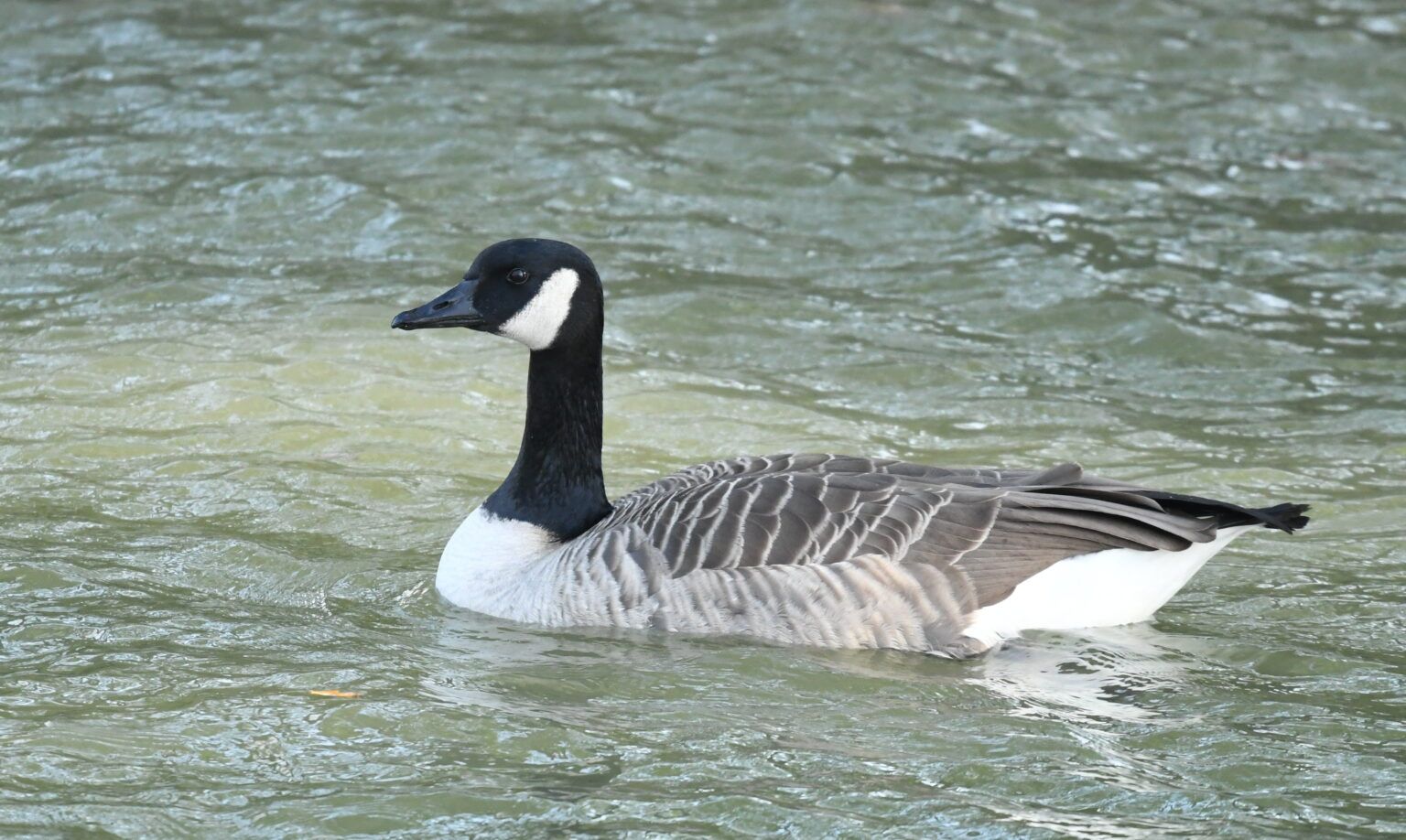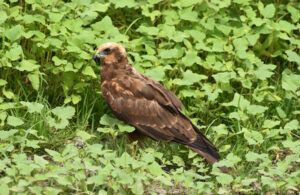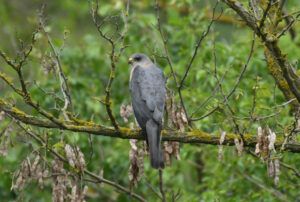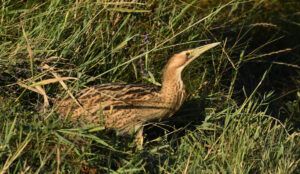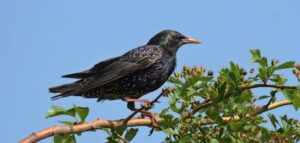The Canada goose (Branta canadensis) is a large wild goose species with a black head and neck, white patches on the face, and a brown body. Native to arctic and temperate regions of North America, its migration occasionally reaches northern Europe. It has been introduced to the United Kingdom, New Zealand, Argentina, Chile, and the Falkland Islands. Like most geese, the Canada goose is primarily herbivorous and normally migratory; it tends to be found on or close to fresh water.
Extremely successful at living in human-altered areas, Canada geese have proven able to establish breeding colonies in urban and cultivated areas, which provide food and few natural predators, and are well known as a common park species. Their success has led to them often being considered a pest species because of their depredation of crops and issues with their noise, droppings, aggressive territorial behavior, and habit of begging for food (caused by human hand feeding), especially in their introduced range. Canada geese are also among the most commonly hunted waterfowl in North America.

The Canada goose was one of the many species described by Carl Linnaeus in his 18th-century work Systema Naturae. It belongs to the Branta genus of geese, which contains species with largely black plumage, distinguishing them from the grey species of the Anser genus.
Branta is a Latinised form of Old Norse Brandgás, “burnt (black) goose” and the specific epithet canadensis is a New Latin word meaning “from Canada”. According to the Oxford English Dictionary, the first citation for the ‘Canada goose’ dates back to 1772. The Canada goose is also colloquially referred to as the “Canadian goose”.
The cackling goose was originally considered to be the same species or a subspecies of the Canada goose, but in July 2004, the American Ornithologists’ Union’s Committee on Classification and Nomenclature split them into two species, making the cackling goose into a full species with the scientific name Branta hutchinsii. The British Ornithologists’ Union followed suit in June 2005.
The AOU has divided the many subspecies between the two species. The subspecies of the Canada goose were listed as:
- Atlantic Canada goose, B. c. canadensis
- Interior Canada goose, B. c. interior
- Giant Canada goose, B. c. maxima
- Moffitt’s Canada goose, B. c. moffitti
- Vancouver Canada goose, B. c. fulva
- Dusky Canada goose, B. c. occidentalis
- Lesser Canada goose, B. c. parvipes
The distinctions between the two geese have led to confusion and debate among ornithologists. This has been aggravated by the overlap between the small types of Canada goose and larger types of cackling goose. The old “lesser Canada goose” was believed to be a partly hybrid population, with the birds named B. c. taverneri considered a mixture of B. c. minima, B. c. occidentalis, and B. c. parvipes. In addition, the barnacle goose has been determined to be a derivative of the cackling goose lineage, whereas the Hawaiian goose is derived from the Canada goose.
The black head and neck with a white “chinstrap” distinguish the Canada goose from all other goose species, with the exception of the cackling goose and barnacle goose (the latter, however, has a black breast and gray rather than brownish body plumage).
The seven subspecies of this bird vary widely in size and plumage details, but all are recognizable as Canada geese. Some of the smaller races can be hard to distinguish from the cackling goose, which slightly overlap in mass. However, most subspecies of the cackling goose (exclusive of Richardson’s cackling goose, B. h. hutchinsii) are considerably smaller. The smallest cackling goose, B. h. minima, is scarcely larger than a mallard. In addition to the size difference, cackling geese also have a shorter neck and smaller bill, which can be useful when small Canada geese comingle with relatively large cackling geese. Of the “true geese” (i.e. the genera Anser, Branta or Chen), the Canada goose is on average the largest living species, although some other species that are geese in name, if not of close relation to these genera, are on average heavier such as the spur-winged goose and Cape Barren goose.
Canada geese range from 75 to 110 cm (30 to 43 in) in length and have a 127–185 cm (50–73 in) wingspan. Among standard measurements, the wing chord can range from 39 to 55 cm (15 to 22 in), the tarsus can range from 6.9 to 10.6 cm (2.7 to 4.2 in) and the bill can range from 4.1 to 6.8 cm (1.6 to 2.7 in). The largest subspecies is the B. c. maxima, or the giant Canada goose, and the smallest (with the separation of the cackling goose group) is B. c. parvipes, or the lesser Canada goose. An exceptionally large male of race B. c. maxima, which rarely exceed 8 kg (18 lb), weighed 10.9 kg (24 lb) and had a wingspan of 2.24 m (7.3 ft). This specimen is the largest wild goose ever recorded of any species.
The male Canada goose usually weighs 2.6–6.5 kg (5.7–14.3 lb), averaging amongst all subspecies 3.9 kg (8.6 lb). The female looks virtually identical, but is slightly lighter at 2.4–5.5 kg (5.3–12.1 lb), averaging amongst all subspecies 3.6 kg (7.9 lb), and generally 10% smaller in linear dimensions than the male counterparts. The female also possesses a different, and less sonorous, honk than the male.
This species is native to North America. It breeds in Canada and the northern United States in a variety of habitats. The Great Lakes region maintains a very large population of Canada geese. Canada geese occur year-round in the southern part of their breeding range, including most of the eastern seaboard and the Pacific coast. Between California and South Carolina in the southern United States and northern Mexico, Canada geese are primarily present as migrants from further north during the winter.
By the early 20th century, overhunting and loss of habitat in the late 19th century and early 20th century had resulted in a serious decline in the numbers of this bird in its native range. The giant Canada goose subspecies was believed to be extinct in the 1950s until, in 1962, a small flock was discovered wintering in Rochester, Minnesota, by Harold Hanson of the Illinois Natural History Survey. In 1964, the Northern Prairie Wildlife Research Center was built near Jamestown, North Dakota. Its first director, Harvey K. Nelson, talked Forrest Lee into leaving Minnesota to head the center’s Canada goose production and restoration program. Forrest soon had 64 pens with 64 breeding pairs of screened, high-quality birds. The project involved private, state, and federal resources and relied on the expertise and cooperation of many individuals. By the end of 1981, more than 6,000 giant Canada geese had been released at 83 sites in 26 counties in North Dakota. With improved game laws and habitat recreation and preservation programs, their populations have recovered in most of their range, although some local populations, especially of the subspecies B. c. occidentalis, may still be declining.

In recent years, Canada goose populations in some areas have grown substantially, so much so that many consider them pests for their droppings, bacteria in their droppings, noise, and confrontational behavior. This problem is partially due to the removal of natural predators and an abundance of safe, man-made bodies of water near food sources, such as those found on golf courses, in public parks and beaches, and in planned communities. Due in part to the interbreeding of various migratory subspecies with the introduced nonmigratory giant subspecies, Canada geese are frequently a year-around feature of such urban environments.
Contrary to its normal migration routine, large flocks of Canada geese have established permanent residence in Esquimalt, British Columbia, on Chesapeake Bay, in Virginia’s James River regions, and in the Triangle area of North Carolina (Raleigh, Durham, Chapel Hill), and nearby Hillsborough. Some Canada geese have taken up permanent residence as far south as Florida, in places such as retention ponds in apartment complexes. Large resident populations of Canada geese are also present in much of the San Francisco Bay area in Northern California. In 2015, the Ohio population of Canada geese was reported as roughly 130,000, with the number likely to continue increasing. Many of the geese, previously migratory, reportedly had become native, remaining in the state even in the summer. The increase was attributed to a lack of natural predators, an abundance of water, and plentiful grass in manicured lawns in urban areas. Canada geese were eliminated in Ohio following the American Civil War, but were reintroduced in 1956 with 10 pairs. The population was estimated at 18,000 in 1979. The geese are considered protected, though a hunting season is allowed from September 1–15, with a daily bag limit of five.
Canada geese have reached Northern Europe naturally, as has been proved by ringing recoveries. The birds include those of the subspecies B. c. parvipes, and possibly others. These geese are also found naturally on the Kamchatka Peninsula in eastern Siberia, and eastern China.[citation needed]
Canada geese have also been introduced in Europe, and had established populations in Great Britain in the middle of the eighteenth century, Ireland, the Netherlands, Belgium, France, Germany, Scandinavia, and Finland. Most European populations are not migratory, but those in more northerly parts of Sweden and Finland migrate to the North Sea and Baltic coasts. Semitame feral birds are common in parks, and have become a pest in some areas. In the early 17th century, explorer Samuel de Champlain sent several pairs of geese to France as a present for King Louis XIII. The geese were first introduced in Britain in the late 17th century as an addition to King James II’s waterfowl collection in St. James’s Park. They were introduced in Germany and Scandinavia during the 20th century, starting in Sweden in 1929. In Britain, they were spread by hunters, but remained uncommon until the mid-20th century. Their population grew from 2200–4000 birds in 1953 to an estimated 82,000 in 1999, as changing agricultural practices and urban growth provided new habitat. European birds are mostly descended from the subspecies B. c. canadensis, likely with some contributions from the subspecies B. c. maxima.
Like most geese, the Canada goose is naturally migratory with the wintering range being most of the United States. The calls overhead from large groups of Canada geese flying in V-shaped formation signal the transitions into spring and autumn. In some areas, migration routes have changed due to changes in habitat and food sources. In mild climates from California to the Great Lakes, some of the population has become nonmigratory due to adequate winter food supply and a lack of former predators. 
Males exhibit agonistic behaviour both on and off breeding and nesting grounds. This behavior rarely involves interspecific killing. One documented case involved a male defending his nest from a brant goose that wandered into the area; the following attack lasted for one hour until the death of the brant. The cause of death was suffocation or drowning in mud as a direct result of the Canada goose’s pecking the head of the brant into the mud. Researchers attributed it to high hormone levels and the brant’s inability to leave the nesting area.
Canada geese are primarily herbivores, although they sometimes eat small insects and fish.Their diet includes green vegetation and grains. The Canada goose eats a variety of grasses when on land. It feeds by grasping a blade of grass with the bill, then tearing it with a jerk of the head. The Canada goose also eats beans and grains such as wheat, rice, and corn when they are available. In the water, it feeds from silt at the bottom of the body of water. It also feeds on aquatic plants, such as seaweeds. In urban areas, it is also known to pick food out of garbage bins.They are also commonly hand fed a variety of grains by humans in parks all over America.
During the second year of their lives, Canada geese find a mate. They are monogamous, and most couples stay together all of their lives. If one dies, the other may find a new mate. The female lays from two to nine eggs with an average of five, and both parents protect the nest while the eggs incubate, but the female spends more time at the nest than the male.
Its nest is usually located in an elevated area near water such as streams, lakes, ponds, and sometimes on a beaver lodge. Its eggs are laid in a shallow depression lined with plant material and down.
The incubation period, in which the female incubates while the male remains nearby, lasts for 24–28 days after laying. As the annual summer molt also takes place during the breeding season, the adults lose their flight feathers for 20–40 days, regaining flight about the same time as their goslings start to fly.
As soon as the goslings hatch, they are immediately capable of walking, swimming, and finding their own food (a diet similar to the adult geese). Parents are often seen leading their goslings in a line, usually with one adult at the front, and the other at the back. While protecting their goslings, parents often violently chase away nearby creatures, from small blackbirds to lone humans who approach, after warning them by giving off a hissing sound and then attack with bites and slaps of the wings if the threat does not retreat or has seized a gosling. Canada geese are especially protective animals, and will sometimes attack any animal nearing its territory or offspring, including humans. Most of the species that prey on eggs also take a gosling. Although parents are hostile to unfamiliar geese, they may form groups of a number of goslings and a few adults, called crèches.
The offspring enter the fledgling stage any time from 6 to 9 weeks of age. They do not leave their parents until after the spring migration, when they return to their birthplace.
Canada geese fly in a distinctive V-shaped flight formation, with an altitude of 1 km (3,000 feet) for migration flight. The maximum flight ceiling of Canada geese is unknown, but they have been reported at 9 km (29,000 feet).
Flying in the V formation has been the subject of study by researchers. The front position is rotated since flying in front consumes the most energy. Canada geese leave the winter grounds more quickly than the summer grounds. Elevated thyroid hormones, such as T3 and T4, have been measured in geese just after a big migration. This is believed because of the long days of flying in migration the thyroid gland sends out more T4 which help the body cope with the longer journey. The increased T4 levels are also associated with increased muscle mass (hypertrophy) of the breast muscle, also because of the longer time spent flying. It is believed that the body sends out more T4 to help the goose’s body with this long task by speeding up the metabolism and lowering the temperature at which the muscles work. Also, other studies show levels of stress hormones such as corticosterone rise dramatically in these birds during and after a migration.
In 2000, the North American population for the geese was estimated to be between 4 million and 5 million birds. A 20-year study from 1983 to 2003 in Wichita, Kansas, found the size of the winter Canada goose population within the city limits increase from 1,600 to over 18,000 birds

